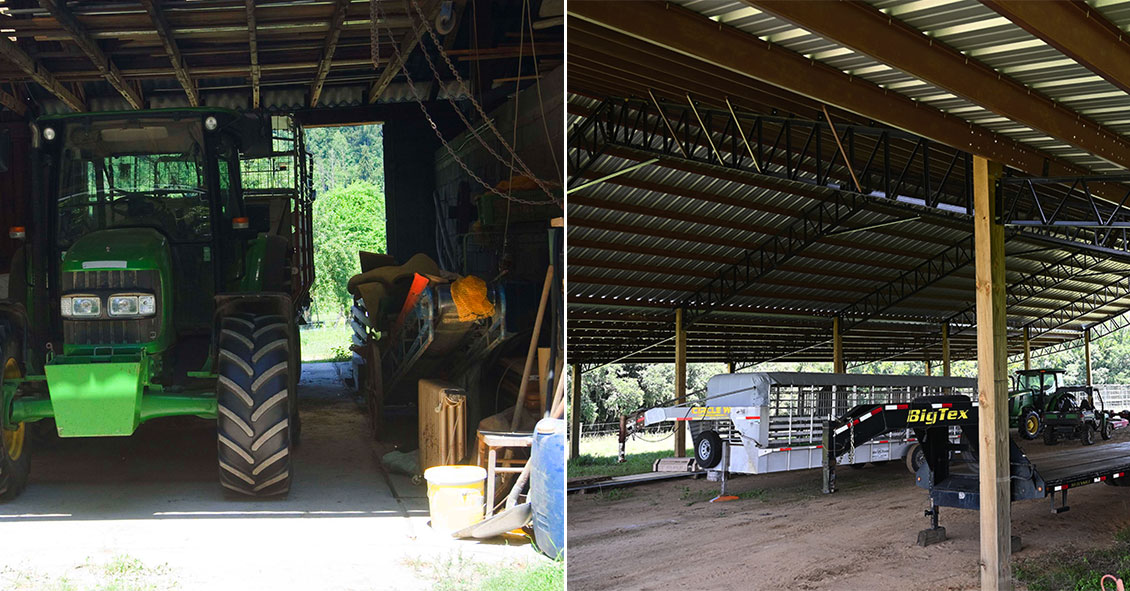Pole Barns vs Traditional Barns: Pros and Cons
August 23, 2023

When it comes to practical structures, barns are seen as versatile workhorses, serving as guardians of valuable resources and integral components of agriculture operations across the nation’s heartland. As the needs of these industries evolve, so too do the options available for constructing these essential spaces.
Gone are the days of a one-size-fits-all approach to barn construction. Let’s take a look at two of the choices at hand: pole barns and traditional barns, focusing on the contemporary advantages and considerations of each.
Design and Construction: Pole Barns vs. Traditional Barns
Pole Barns
Pole barns revolutionize traditional construction techniques through the innovative use of post-frame architecture. This approach involves securing vertical poles deeply into the ground, forming a sturdy foundation that supports the entire structure. These poles lend exceptional stability and they streamline the building process, which reduces the need for extensive excavation and complex foundation work. By relying on the strength of poles, trusses, and roof, pole barns efficiently allow for larger spans of space and a quicker construction timeline.
One of the hallmarks of pole barns is their wide open and flexible interiors. With strategically placed vertical poles serving as primary supports, the interior space remains unobstructed and versatile, providing a blank canvas for various layouts and purposes. This uncluttered design grants you the freedom to adapt the space according to your specific needs, whether you're storing equipment, setting up workstations, or housing livestock. The absence of interior walls not only maximizes the usable space but also offers a heightened sense of openness that resonates with the demands of modern functionality.
Traditional Barns
Traditional barns can be architectural testaments to craftsmanship and often use historical building methods. These structures use intricate framing techniques, with a complex interplay of beams, rafters, and framing members. Frames are usually meticulously assembled, with each component serving a specific purpose in distributing the building's weight and enduring the tests of time. This meticulous craftsmanship creates barns that exude a timeless charm that resonates with the past and they withstand harsh elements of Mother Nature.
A defining feature of traditional barns is the presence of load-bearing walls and interior divisions. The framework, though intricate, necessitates interior walls for structural integrity. These load-bearing walls provide critical support to the roof and upper levels. The interior divisions, while rooted in practicality, also contribute to the barn's unique character, often creating distinct sections for various purposes, from hay storage to livestock housing. This arrangement, while intended as a multifunctional space to encapsulate diverse needs can sometimes be limiting to needs across generations of use.
Which Barn is Most Cost-Effective?
Pole Barns
When it comes to cost-effectiveness, pole barns efficiently balance affordability and functionality. The streamlined construction process of pole barns translates into tangible cost advantages. With fewer components and simplified techniques, the overall material and labor requirements are notably reduced, resulting in direct savings for your project. The vertical pole foundation, a cornerstone of pole barn design, eliminates the need for complex and expensive excavation work, further contributing to the cost-efficiency of these structures.
Moreover, the cost-effectiveness of pole barns isn't limited to the initial investment alone. The efficient construction timeline means that your pole barn can be up and running sooner, allowing you to quickly put the space to use and potentially realize a quicker return on investment. Whether you're considering a pole barn for agricultural purposes, storage, or workshops, the reduced upfront costs and swift construction process make it a financially appealing choice that aligns well with contemporary demands for practicality and savings.
Traditional Barns
In contrast to pole barns, traditional barns often come with higher costs due to their framing and construction methods. The complexity of the framework, involving a myriad of beams, rafters, and detailed joinery, translates into increased material requirements and requires more labor during construction. As a result, the build process is both time-consuming and requires a higher level of craftsmanship, potentially contributing to escalated labor costs. The upfront expenses associated with traditional barns can be considerable, especially when considering the materials and expertise involved.
Pole Barns or Traditional Barns -Versatility and Customization
Pole Barns
The open interiors of pole barns can be used for a range of needs and industries. These spaces can be customized for diverse purposes, from housing equipment and machinery to serving as workshops, storage areas, or even livestock shelters. This inherent flexibility means that pole barns can used in different industries, making them an attractive choice for agricultural, commercial, or even residential applications.
Beyond their initial purpose, one of the key advantages of pole barns lies in their adaptability over time. As your needs change or expand, these structures can be easily modified or extended. The absence of interior walls allows for straightforward reconfigurations, while the sturdy vertical poles provide a solid foundation upon which additions can be seamlessly integrated. This scalability ensures that pole barns can grow alongside your endeavors, accommodating new equipment, or evolving business ventures without the need for extensive renovation or rebuilding.
Traditional Barns
The interior layout of traditional barns presents challenges when it comes to modifications. With load-bearing walls intricately integrated into their designs, altering the internal structure can be complex and costly. The historical intention of traditional barns was often tied to specific agricultural needs of the past, which can limit their suitability for modern applications. These structures were constructed to cater to practices that have evolved over time, potentially making them less compatible with the demands of present-day industries.
Adapting traditional barns to modern uses often necessitates extensive renovations. The historical design, while charming and iconic, may not align with the spatial requirements or functional needs of contemporary applications. Converting these structures to accommodate modern equipment, different livestock arrangements, or alternative storage purposes can require substantial investment, involving modifications to framing, roofing, and other critical components. While traditional barns hold cultural and historical significance, repurposing them for today's needs can be a complex and costly undertaking, sometimes outweighing their charm with practical challenges.
Maintenance and Longevity in Barns
Pole Barns
Pole barns stand out for their minimal maintenance requirements, owing to the use of durable materials that are well-suited for longevity. Materials like rust-resistant metal and pressure-treated wood contribute to the overall durability of these structures, reducing the need for frequent repairs and replacements. Metal components are often coated with protective finishes that prevent corrosion over time, ensuring the integrity of the structure even in harsh environments.
However, while pole barns are known for their durability, regular inspections are still crucial to ensure their continued longevity. Luckily, with their open layout and exposed beams, and trusses, finding any problems is as easy as giving them an up-close inspection once a year. Regular check-ups allow for early detection of any potential issues that might arise, allowing you to address them before they develop into more significant problems. By addressing any minor repairs promptly, you can extend the life of your pole barn and preserve its structural integrity for years to come.
Traditional Barns
Maintenance challenges are inherent in the complex structure of traditional barns, often requiring ongoing attention to preserve their integrity. Traditional barns are susceptible to issues such as wood rot, termite damage, and the natural deterioration of their original building materials. The intricate framework of beams and rafters can trap and hide moisture and lead to rot over time, especially in areas where proper ventilation is lacking. Additionally, the organic nature of wood can attract termites and other pests, potentially compromising the structural stability of these historic structures.
Comparing the Aesthetics and Nostalgia of Barns
Pole Barns
Pole barns are known for their modern utilitarian appearance, emphasizing clean lines and practical functionality. Unlike the ornate and often intricate designs of traditional barns, pole barns have a straightforward aesthetic. This minimalist approach not only aligns with modern sensibilities but also contributes to the efficient use of materials and resources.
The favorability of pole barns lies in their ability to harmoniously blend into a variety of settings, from rural landscapes to urban environments. The uncluttered design of pole barns makes them versatile structures that can serve diverse purposes while maintaining a cohesive and unobtrusive presence. Whether as agricultural storage, commercial spaces, workshops, or even residential structures, the clean and practical lines of pole barns ensure that they remain adaptable to the evolving needs of modern life.
Traditional Barns
Traditional barns are renowned for their timeless and rustic aesthetic that evokes a sense of nostalgia and connection to the past. Their iconic design, characterized by aged wood, intricate beams, and classic silhouettes, exudes a charm that resonates with those who appreciate the authenticity of historical architecture. This traditional aesthetic not only adds character to the landscape but also stands as a reminder of the enduring heritage of farming and craftsmanship.
Beyond their visual appeal, the sentimental value and historical significance of traditional barns are immeasurable. Preserving traditional barns is an act of honoring our cultural roots and paying homage to the individuals who toiled within their walls. As the modern world progresses, the sentimental connection to these structures becomes even more precious, making their maintenance and restoration a meaningful endeavor that transcends architectural value and enriches the fabric of our shared history.
Deciding Between a Pole Barn or a Traditional Barn
The choice between pole barns and traditional barns need not be a tough decision. We've explored the advantages and considerations of both options, shedding light on the distinct attributes that define each type.
Pole barns, with their streamlined construction, open interiors, and adaptability, present a modern solution tailored to the demands of efficiency and flexibility. Their utilitarian design and potential for quick return on investment make them a solid choice for various industries and applications. But for some, the draw of nostalgia and rustic charm weigh heavy in their decision, even considering higher costs and the demand for ongoing maintenance.
If you’re seeking streamlined functionality, a pole barn is a practical solution. To take your decision a step further, start looking at what you need to know before building a pole barn.
To start considering which pole barn is right for you, talk to one of our subject matter experts at Matador.











